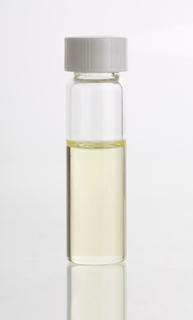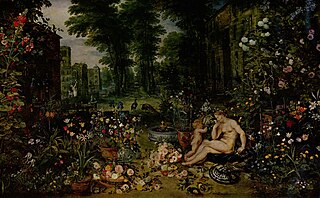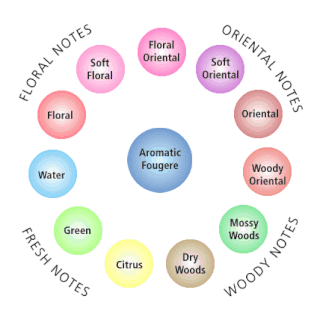
Perfume is a mixture of fragrant essential oils or aroma compounds, fixatives and solvents, used to give the human body, animals, food, objects, and living-spaces an agreeable scent. It is usually in liquid form and used to give a pleasant scent to a person's body. Ancient texts and archaeological excavations show the use of perfumes in some of the earliest human civilizations. Modern perfumery began in the late 19th century with the commercial synthesis of aroma compounds such as vanillin or coumarin, which allowed for the composition of perfumes with smells previously unattainable solely from natural aromatics alone.

An essential oil is a concentrated hydrophobic liquid containing volatile chemical compounds from plants. Essential oils are also known as volatile oils, ethereal oils, aetherolea, or simply as the oil of the plant from which they were extracted, such as oil of clove. An essential oil is "essential" in the sense that it contains the "essence of" the plant's fragrance—the characteristic fragrance of the plant from which it is derived. The term "essential" used here does not mean indispensable or usable by the human body, as with the terms essential amino acid or essential fatty acid, which are so called because they are nutritionally required by a given living organism.
Smell-O-Vision was a system that released odor during the projection of a film so that the viewer could "smell" what was happening in the movie. The technique was created by Hans Laube and made its only appearance in the 1960 film Scent of Mystery, produced by Mike Todd Jr., son of film producer Mike Todd. The process injected 30 odors into a movie theater's seats when triggered by the film's soundtrack.

An aroma compound, also known as an odorant, aroma, fragrance, or flavor, is a chemical compound that has a smell or odor. For a chemical compound to have a smell or odor it must be sufficiently volatile to be transported to the olfactory system in the upper part of the nose.
Fragrance oil(s), also known as aroma oils, aromatic oils, and flavor oils, are blended synthetic aroma compounds or natural essential oils that are diluted with a carrier like propylene glycol, vegetable oil, or mineral oil.
Aromachology is the study of the influence of odors on human behavior and to examine the relationship between feelings and emotions. It analyzes emotions as relaxation, exhilaration, sensuality, happiness and well-being brought about by odors stimulating the olfactory pathways in the brain and, in particular, the limbic system. Different wearers are thought to have unique physiological and psychological responses to scents, especially those not manufactured synthetically but based on real scents. The word "aromachology" is derived from "aroma" and "physio-psychology", the latter being the study of aroma. This term was coined in 1989 by what is now the Sense of Smell Institute (SSI), a division of The Fragrance Foundation. The SSI defines aromachology as 'a concept based on systematic, scientific data collected under controlled conditions'. The term is defined as the scientifically observable influence of smell on emotions and moods. Consumers use aromachology to alleviate time pressures, for relaxation or stimulation and as a component of other activities that generate a feeling of well-being.
Olfactory fatigue, also known as odor fatigue, olfactory adaptation, and noseblindness, is the temporary, normal inability to distinguish a particular odor after a prolonged exposure to that airborne compound. For example, when entering a restaurant initially the odor of food is often perceived as being very strong, but after time the awareness of the odor normally fades to the point where the smell is not perceptible or is much weaker. After leaving the area of high odor, the sensitivity is restored with time. Anosmia is the permanent loss of the sense of smell, and is different from olfactory fatigue.

Rachel Sarah Herz is a Canadian and American psychologist and cognitive neuroscientist, recognized for her research on the psychology of smell.
Pamela Dalton is a cognitive psychologist. She has a Ph.D. in experimental psychology and a Masters in Public Health. Dalton is frequently quoted by the popular press as an authority on environmental odors. She is most notable for her contributions to the research toward the fields of sick building syndrome and multiple chemical sensitivity. In the past she has worked with the United States Department of Defense on nonlethal weapons development, or the enhancement of bad odors as weapons. She currently works at the Monell Chemical Senses Center.

Sandalwood oil is an essential oil obtained from the steam distillation of chips and billets cut from the heartwood of various species of sandalwood trees.

An odor or odour is caused by one or more volatilized chemical compounds that are generally found in low concentrations that humans and animals can perceive by their sense of smell. An odor is also called a "smell" or a "scent", which can refer to either a pleasant or an unpleasant odor.

Olfaction is a chemoreception that, through the sensory olfactory system, forms the perception of smell. Olfaction has many purposes, such as the detection of hazards, pheromones, and food.
Olfactory memory refers to the recollection of odors. Studies have found various characteristics of common memories of odor memory including persistence and high resistance to interference. Explicit memory is typically the form focused on in the studies of olfactory memory, though implicit forms of memory certainly supply distinct contributions to the understanding of odors and memories of them. Research has demonstrated that the changes to the olfactory bulb and main olfactory system following birth are extremely important and influential for maternal behavior. Mammalian olfactory cues play an important role in the coordination of the mother infant bond, and the following normal development of the offspring. Maternal breast odors are individually distinctive, and provide a basis for recognition of the mother by her offspring.

Aromatherapy is a pseudoscience based on the usage of aromatic materials, including essential oils, and other aroma compounds, with claims for improving psychological or physical well-being. It is offered as a complementary therapy or as a form of alternative medicine, the first meaning alongside standard treatments, the second instead of conventional, evidence-based treatments.
Digital scent technology is the engineering discipline dealing with olfactory representation. It is a technology to sense, transmit and receive scent-enabled digital media. This sensing part of this technology works by using olfactometers and electronic noses.

A fragrance wheel, variously called an aroma wheel, a fragrance circle, a perfume wheel or a smell wheel, is a round diagram showing the inferred relationships among olfactory groups based upon similarities and differences in their odor. The groups bordering one another are implied to share common olfactory characteristics. Fragrance wheels are frequently used as a classification tool in oenology and perfumery.
Sensory branding is a type of marketing that appeals to all the senses in relation to the brand. It uses the senses to relate with customers on an emotional level. Brands can forge emotional associations in the customers' minds by appealing to their senses. A multi-sensory brand experience generates certain beliefs, feelings, thoughts and opinions to create a brandgon image in the consumer's mind.

Aroma lamps, or diffusers, are used to diffuse essential oils in aromatherapy and esoterics.
Beard oil is a cosmetic product for men, that is used to nourish the skin under the beard, as well as the beard itself in order to keep it "soft, shiny, and smooth". Beard oil mimics the natural oils produced by skin, such as sebum, and is composed mainly of carrier oils and essential oils.








